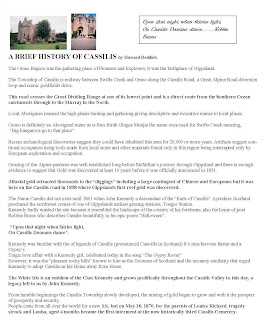The words from the document above.
The Omeo Region was the gathering place of Pioneers and Explorers; it was the birthplace of Gippsland.
The Township of Cassilis is midway between Swifts Creek and Omeo along the Cassilis Road, a Great Alpine Road diversion loop and scenic gold fields drive.
This road crosses the Great Dividing Range at one of its lowest point and is a direct route from the Southern Ocean catchments through to the Murray in the North.
Local Aborigines roamed the high plains hunting and gathering, giving descriptive and evocative names to local places.
Omeo is definitely an Aboriginal name as is Bun Jirrah Gingee Munjie the name once used for Swifts Creek meaning, “Big kangaroos go to that place”
Recent archaeological discoveries suggest they could have inhabited this area for 20,000 or more years. Artefacts suggest continual occupation using tools made from local stone and other materials found only in this region being interrupted only by European exploration and occupation.
Grazing of the Alpine pastures was well established long before McMillan‘s journey through Gippsland and there is enough evidence to suggest that Gold was discovered at least 10 years before it was officially announced in 1851.
Alluvial gold attracted thousands to the “diggings” including a large contingent of Chinese and Europeans but it was here on the Cassilis road in 1858 where Gippslands first reef gold was discovered.
The Name Cassilis did not exist until 1861 when John Kennedy a descendant of the “Earls of Cassilis” Ayrshire Scotland purchased the northwest corner of one of Gippslands earliest grazing stations, Tongio Station. Kennedy badly wanted the site because it resembled the landscape of the country of his forebears, also the home of poet Robbie Burns who describes Cassilis beautifully in his epic poem “Halloween”.
“Upon that night when fairies light,
On Cassilis Doonans dance”.
Kennedy was familiar with the of legends of Cassilis (pronounced Cass-ills in Scotland) It‘s mischievous fairies and a Gypsy’s tragic love affair with a Kennedy girl, celebrated today in the song “The Gypsy Rover” However, it was the “pleasant rocky hills” known to him as the Doonans of Scotland and the uncanny similarity that urged Kennedy to adopt Cassilis as his Home away from Home.
The White Iris is an emblem of the Clan Kennedy and grows prolifically throughout the Cassilis Valley to this day, a legacy left to us by John Kennedy.
From humble beginnings the Cassilis Township slowly developed, the mining of gold began to grow and with it the prospect of prosperity and security.
People came from all over the world for anew life, but on May 16, 1870, for the parents of Louisa Richard, tragedy
struck and Louisa, aged 4 months became the first interment at the now historically listed Cassilis Cemetery.




route04srs.jpg)















.jpg)
